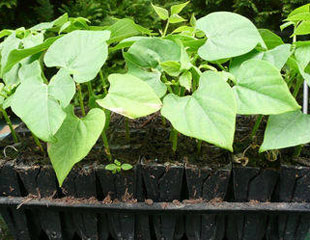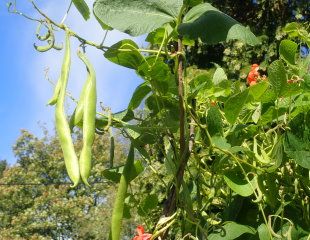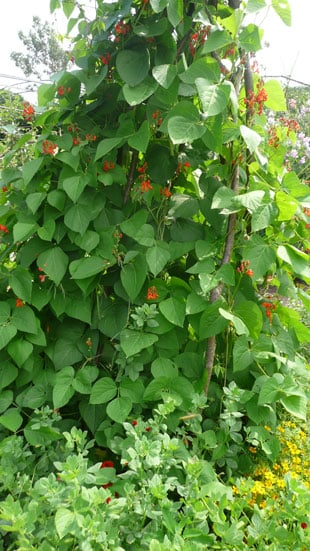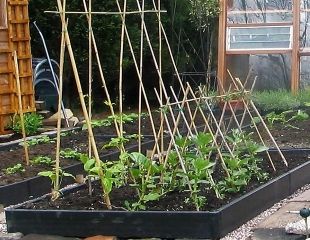


How to Grow Runner Beans
If you want to grow your own veg, Runner beans are a great starting point because they are one of the easiest crops to grow. The seeds are large, which means they are easy to handle, fast growing and quick to germinate (within about 5-7 days of sowing.) Runner Beans will crop in most conditions and are almost pest and disease free. It is worthwhile growing runner beans from seed because they germinate so easily and this makes the crop cheaper.
There are many types of beans grown in the UK, Runner, Broad, and French beans are the most popular and all have slightly different growing requirements.
Some Runner beans have attractive flowers, the image above centre is a variety called Hestia, a short variety suitable for containers.

I tagged Runner Beans Green Wheelbarrow crop, being easy to germinate and grow.
How to Grow Runner beans from seed, when to Sow and Plant out Runner Beans
Runner beans are not fully hardy, so one of the most important points is not to plant outside until the risk of frost has passed.
If you are growing Runner Beans from seed early in the year, they need to be germinated indoors, under glass from around mid-April onwards. By this time, there should be enough warmth and heat in the sun to ensure the beans germinate. As with all beans, Runner Beans have long roots, and need to be sown into deep, not shallow container. You can sow Runner Beans in especially purchased root trainers (image above far left.) Fill the containers with good compost, damp and firm down to eliminate any air pockets and place the bean 5cms from top. Sprinkle with compost and place in a light, warm place and germination will be swift, a matter of days. Alternatively, you can sow into toilet roll holders, just take care when watering, not to over wet the cardboard tube or it will turn black and soggy.
If sowing Runner Beans outside, or planting out small plants, delay until Mid-May ( or late May depending on where you garden in the country) to avoid frost.
Beans often need slug protection until the plants get started, after which they need little or no attention throughout the growing season.
How to plant Runner Beans

Unlike Broad beans, Runner Beans will climb and climb high. They naturally twine and climb and the traditional way of growing Runner Beans is up a teepee made of canes or twigs as shown in the image left. You can also plant in double rows 60 cm apart, 5cms deep and place a plant or seed every 15cms. Runner Beans grow tall, and it is essential to provide Runner Beans with tall stakes to grow up. See illustration left. You can use bamboo canes to sink firmly into the ground and angle inwards together, and tie securely at the top. Place another cane horizontally along the top and tie this cane in as well, which will give strength to the structure to prevent the Runner Beans from being blown over.
You can also use small sapling, branches and twigs instead of bamboo canes (see free plant supports,) which, from the purely aesthetic point of view, look more attractive in the veg plot. As illustrated, Runner beans look good with companion planting and benefit in terms of pollinators from Calendula planted alongside. A bright zingy orange, and flowering for a long time, Calendula, the English Pot Marigold, will bring in some extra pollinators. An added benefit is that the slugs do not seem very interested in Calendula, as compared with French Marigolds, which are often reduced to slimy sticks in my garden. Calendula are an easier alternative if you battle with slugs.

Runner beans can outgrow even quite tall supports, for which reason it is best to pinch out the growth points when they reach the top of the poles, otherwise they just keep on growing. Left unchecked, they will grow into a top tangle. By pinching out the runner beans, you are diverting the plant's energies into making flowers, which become the beans, rather than miles of growth.
Growing Runner Beans really is as easy as that. Usually, runner beans crop prolifically, although a poor summer can reduce yields. If it is cool and wet, there will be fewer flowers and a lack of pollinators, which will reduce yields.
Each plant will yield many beans, which means a short row or teepee will produce quite a lot of beans. To avoid gluts, sow or plant out successively, every fortnight is a good rule of thumb so that the plants fruit at different times. What to do with a glut of runner beans- click here for some ideas.
Runner beans will fruit for a long period right up to the first frosts. In a good summer with a mild autumn, such as 2014, beans were picked up to November.
What can go wrong when growing Runner Beans?
Not very much. Runner beans are tender and so a chilly spring (and summer) can reduce growth, the production of flowers and pollinators resulting in a reduced yield. It is best not to sow directly unless the soil has reached 12C. Poor germination will occur if the soil is not warm enough, in which circumstances it is best to start under glass, transplant into the veg plot in late May or early June when it is warm, after hardening off.
Young plants will struggle if in a cold or exposed area, so if the weather does decline, protect the plants. Runner beans also need regular watering during dry spells. Slugs and snails can be a problem attacking the tender new growth as it emerges. When the plants are first emerging or freshly planted, it is best to protect from slugs and snails.
Best Runner beans to grow
A quality mark for any plant, veg or shrub is the RHS garden merit award. This is an award from the Royal Horticultural Society, which follows plant trials to judge the plant's performance under growing conditions in the UK. A plant or veg with this award will be a reliable performer and it is a good guide when choosing which varieties to grow to look for those plants with the RHS award. In 2013, the RHS undertook a growing trial in respect of runner beans looking at taste, colour, pod qualities (as in straightness, length and lack of stringiness) resistance to pests and yields.
The runner beans which performed best in the trials and have the RHS award: St George, Snowstorm, Moonlight, Wisley Magic, Stardust, Firestorm and Firelight.
More about growing Runner beans check out Suttons Bean Blog with a collection of good gardening advice.
